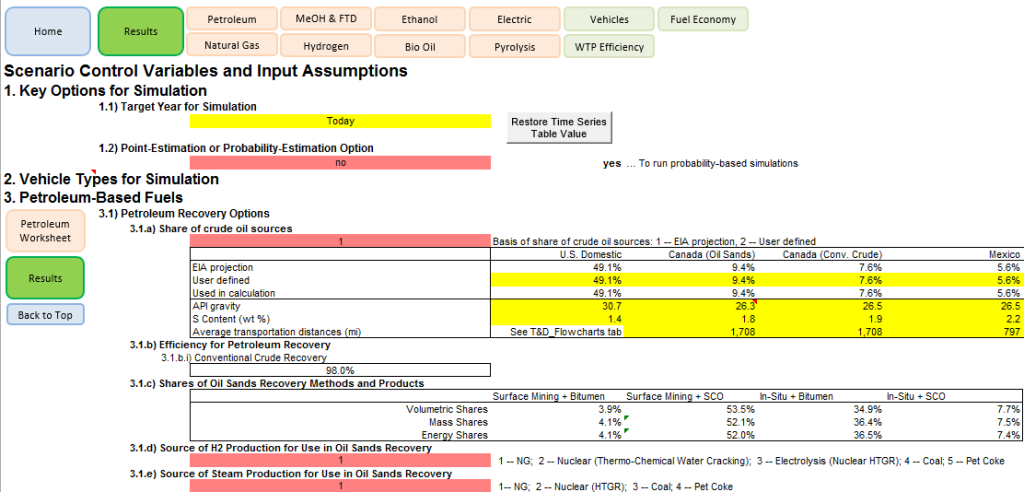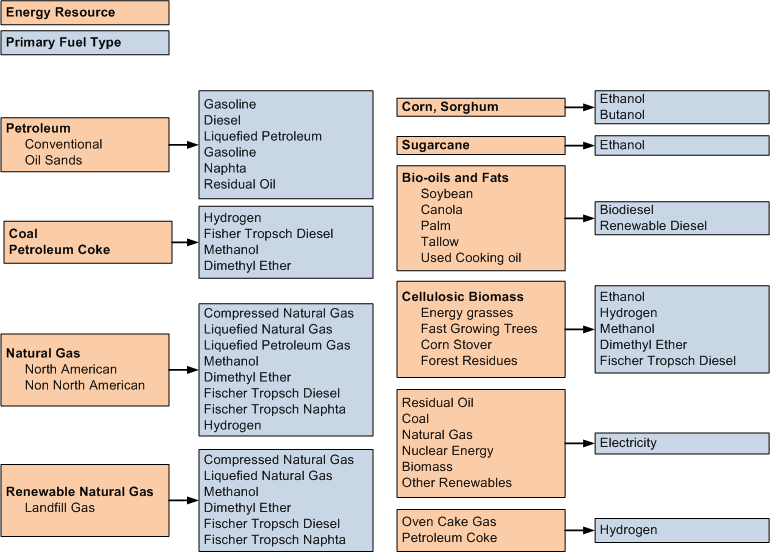The Greenhouse gases, Regulated Emissions and Energy in Transportation (GREET) model has become the standard in performing life cycle analyses of transportation fuels. GREET is a publicly available spreadsheet model developed at the Argonne National Laboratory (ANL) that can be downloaded and run from a user’s computer. The model is an Excel spreadsheet workbook with several macros that can be used directly or manipulated with a graphical user interface (GUI) packaged with the model download. The GUI is considered unhelpful by many because it obscures access to the inputs and facilitates input to only a limited set of key assumptions.
What GREET Does
GREET models emissions of the three traditional greenhouse gases (CO2, CH4 and N2O) and the criteria pollutants from transportation fuels used in the United States. Global warming potential (GWP) values are used to aggregate the three GHG species emissions into a single carbon dioxide equivalent (CO2e) result. Volatile organic compounds (VOC) and carbon monoxide (CO) are counted in their fully oxidized forms as CO2.

The main sheets in the GREET workbook include a summary of the main input parameters for all fuel pathways, a fuel production time series sheet, which contains input parameters varying by target year, fuel pathway sheets that calculate results, and a results sheet summarizing the well-to-wheels (WTW) results in g/mi for most fuel pathways. Inputs to the model are executed in several input sheets. In addition, data are introduced on a time series sheet, on worksheets for each fuel pathway, and inside calculation cells. The variety of input locations is confusing to users without extensive GREET experience.
The “Vehicle” sheet organizes vehicle fuel efficiency and emission factors. But, the model does not show the fuel carbon separately from combustion methane and nitrous oxide for tailpipe emissions. Most analysts want to understand these separately and compare WTW emissions on a g CO2e/MJ fuel basis. The model does not present results by fuel pathway component, nor separate well-to-tank (WTT) and tank-to-wheels (TTW) emissions in g CO2e/MJ in one convenient place. The model does present WTT calculations disaggregated into “feedstock” and “fuel” results, but further disaggregation requires considerable effort.
GREET Fuel Pathways
The GREET model includes provisions for a wide range of feedstocks, fuels, and vehicles. GREET includes more than 100 fuel pathways including petroleum fuels, natural gas fuels, biofuels, hydrogen and electricity produced from various energy feedstock sources. The figure below shows the grouping of pathways by feedstock used for grouping in the model (ANL, 2013).

Each primary fuel type (i.e. Ethanol, Electricity, Natural Gas, etc.) can be produced from a single or several energy resources. Each step in the fuel pathway is described in detail in the model and the supporting pathway documents, which include itemized contributions of the successive processes defined in the system boundary that are required to make the final fuel.
GREET models fuel production pathways and vehicle/fuel combinations for the time period 1990 – 2020 in five-year increments and models light- and heavy-duty conventional spark ignition vehicles, direct injection spark and compression ignition vehicles, grid-independent hybrid electric vehicles, grid-connected hybrid vehicles (PHEVs), battery-powered electric vehicles (BEVs), and fuel cell vehicles (FCVs).
Updates to the GREET Model
ANL continues to publish updated GREET versions with new pathways. Version 1.8c is used by the EPA for the RFS2 analysis. Life Cycle Associates modified Version 1.8b for the California Low Carbon Fuel Standard (LCFS).
The latest version of GREET is GREET_1_2022 and 45VH2-GREET for hydrogen as shown below:

Documentation for the GREET Model
The documentation for the GREET model is extensive and is accessible through the ANL website. Nonetheless, there is not one all-encompassing, up-to-date report on the most recent version of the GREET model. GREET documentation spans over 10 years, with initial reports and subsequent update reports and user manuals. Therefore, finding the answer to a specific question about an assumption or calculation in the model is not straightforward. Documentation to GREET is provided through a brief memo that describes the references for 11 updates to the model. The result of the current approach is a patchwork of inputs and analysis that is not comprehensive.
Our Experience with Using GREET
Life Cycle Associates has extensive experience using and modifying GREET. We specifically modified the model for use by the California Air Resources Board (ARB) in establishing the Low Carbon Fuel Standard (LCFS). And our proprietary software products (T1E and MOUSE) are designed to work with the GREET model. This experience has given us intimate knowledge of the inner workings of the GREET model, and experience in navigating its many nuances.
